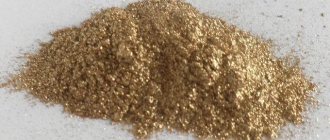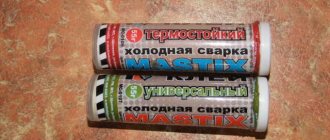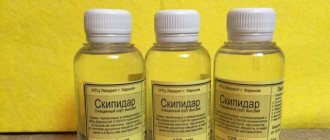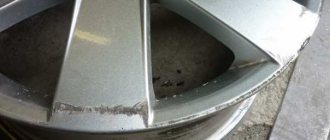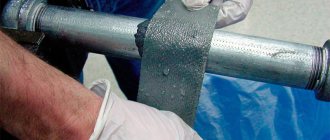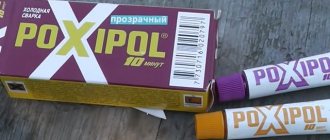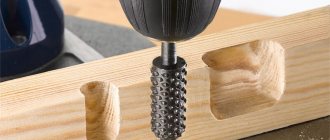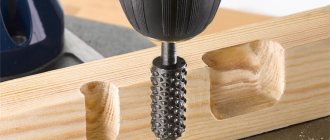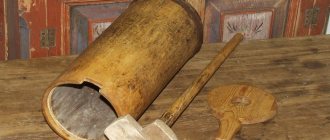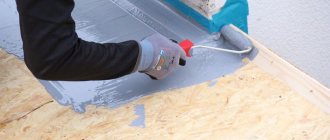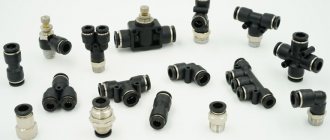Bronze powder, by definition, is a fine powder composition. The material is made from two metal alloys - zinc and copper. Paraffin and stearic acid are added to it to prevent sticking and oxidation of very fine particles. Bronze powder has a scaly structure that resembles the appearance of a petal. It has a color ranging from red to gold. It may have a certain shade - it depends on the percentage of zinc in the composition.
Production
The product is produced exclusively industrially, by repeated crushing of bronze powder. The procedure is carried out in special pneumatic installations or ball mills. Bronze powder is extracted from pure copper and zinc-based alloys by grinding. The end result is a powdery mass containing millions of tiny particles. High-grade bronze powder is obtained by passing through sieve number 0045. The final residue is 1%. Paints and varnishes and coatings based on bronze powder have a high hiding power, which is 4500 grams per square centimeter.
Bronze paint based on bronze powder: preparation and use
Paint made from bronze powder is successfully used to decorate products made from various materials.
Using this paint, you can give a characteristic texture and metallic shine not only to metal, but also to materials such as glass, plaster, cardboard, concrete, plastic, etc.
The reliability of adhesion of such a coating to the surface of the product being painted is determined by the characteristics of the binder material that was used to prepare the paint.
Bronze paint is often used to restore the finishing coatings of antique objects.
Main component of bronze paint
The main component of the paint, which allows you to paint products from various materials in a beautiful metallic color, is bronze powder. This powder, characterized by a very fine fraction, is produced by grinding metal in special mills.
The metal that determines the color of the resulting powder can be pure copper or its zinc alloys. Depending on the metal used, the color of bronze powder varies from light golden to quite rich red.
Bronze paint base is fine-grained copper alloy powder
The quality of painting is influenced not only by the composition of the material, but also by the size of the bronze powder fraction. Thus, paint powder is considered one of the best in quality, which, when sifted through a sieve numbered 0.045, gives a residue of no more than 1%.
In order to obtain bronze powder, the particles of which have a scaly shape, when grinding metal, this process is carried out with the addition of special lubricants to the mills.
The highest quality powder, providing coverage up to 4500 cm2/g, is obtained by grinding not pure copper, but bronze alloys.
Characteristics of bronze powder
Cooking features
In order to make paint from the powder obtained by grinding bronze, it is necessary to mix it with a binder material. The latter affects not only the characteristics of the paint and varnish coating and the scope of its application, but also the cost of the paint. Such a substance can be:
- varnishes intended for processing metal or wood;
- certain types of adhesive compositions;
- gelatin;
- egg powder dissolved in water, etc.
The components of bronze paint are thoroughly mixed before use and during the painting process, since metal particles quickly precipitate
The type of surface that will be painted with such a material influences its choice depending on the degree of its transparency. For example, to prepare bronze paint for wooden products, you can use a clear wood varnish.
The quantitative content of bronze powder in the paint determines the color intensity of the finished coating.
Accordingly, if the goal is to obtain a coating with an intense bronze color, it is necessary to mix a larger amount of metal powder with the binder.
As for the consistency, the finished paint should resemble thick sour cream, then with its help it will be possible to obtain a high-quality and reliable coating.
Sufficiently opaque bronze paint “stretches” behind the brush
Recommendations for use
If you decide to decorate any antique product with bronze paint, you can prepare it yourself or purchase a ready-made composition, which is also sold in aerosol cans.
There are some nuances to using paint made from bronze powder. Naturally, in order for the finished coating to adhere reliably, the surface to be painted must be thoroughly cleaned of dirt and rust (if it is metal). In addition, when painting, you should adhere to the following recommendations.
- To obtain a plastic and, accordingly, more durable finished coating, paint made from bronze powder should be applied in a thin layer. To obtain such a layer, the paint must be thoroughly rubbed over the surface after application (this can be done with a stiff brush or sponge).
- If nitro varnish is used as a binder for bronze paint, then it should be applied as quickly as possible, since it hardens and sets very quickly.
- In order for a bronze paint coating applied to metal to not only perform a decorative function, but also protect the surface from corrosion, the product must first be coated with a primer and only then painted.
A soft natural brush is suitable for applying bronze paint.
Using paint made on the basis of bronze powder, you can effectively solve many problems associated with the processing of various objects and products.
Thus, using bronze paint, any surface can be decorated to look like sparkling metal or give it a touch of noble antiquity.
You can make such paint with your own hands, and in order to use it correctly, you just need to follow a number of simple rules.
Spraying method
Painting by spraying, which uses bronze powder, is used in cases where objects with simple relief are subject to decoration. This coloring is performed in the following sequence.
- First, the surface must be prepared to ensure reliable adhesion of the paint layer to it.
- Dry powder paint is poured in a heap onto gauze laid in several layers. Gauze with sprinkled powder must be tied into a knot.
- A binder, which can be varnish or glue, is applied to the product to be painted. When applying the binder composition with a sponge or fabric swab, you must ensure that no fabric fibers or other foreign inclusions remain in its layer, which will worsen the decorative characteristics of the finished coating.
- While the binder composition has not hardened and is in a fluid state, shake a bundle of metal powder over it. Gauze, folded in several layers, acts as a sieve, through the cells of which only the smallest particles of paint powder spill out. When small particles of bronze powder fall on a layer of varnish or glue that has not yet hardened, they firmly adhere to it, forming a very beautiful and durable coating.
The great advantage of this painting method is that small particles of bronze are not coated with varnish or glue, which means they retain their bright metallic luster.
Painting surfaces with complex relief
The main difficulty in painting products with complex relief is that the finished coating must highlight all the depressions and convex elements in the smallest detail. Such work, in addition to knowledge of painting technology, also requires artistic skill from the performer.
The algorithm for performing this procedure is as follows.
- For surfaces with complex terrain, it is better to use oil varnish as a binder. To give this varnish a golden-brown tint without reducing its transparency too much, brown oil paint is added. In this case, you should buy paint that is specifically designed for artistic work.
- The binder composition tinted in this way is applied to the surface to be painted.
- To spray paint powder onto the object being treated, you can also use a gauze knot, as in the previous case. The subtlety of painting complex relief surfaces lies in the fact that during the process of spraying metal powder they should be placed at an angle. This spraying of powder paint allows you to effectively highlight the protruding parts of the relief, making them more golden.
Having some experience in processing such surfaces, you can predict the results of painting in advance and, accordingly, adjust your actions.
It is not necessary to paint objects with complex relief using the spraying method.
To do this, you can use a simpler method, which involves the use of a pre-prepared coloring composition based on bronze powder, applied with a sponge or cloth swab.
Painting a flat surface
Restoring old coatings or applying a new paint layer to flat surfaces is not particularly difficult. The main thing that you should pay special attention to in such cases is the choice of binding material.
You should also take into account the conditions in which the painted item will be located. Thus, for painting products that are used outdoors, varnishes intended for outdoor use are chosen as a binder.
The painting itself, when all the materials for its implementation are correctly selected, can be carried out using a brush or spray equipment. Often, ready-made compounds produced in aerosol cans are used to perform such work.
Where is the product used?
Bronze powder is widely used in:
- works related to decoration;
- printing industry;
- at enterprises producing paints and coatings;
- pencil production;
- paper coating;
- production of decorative and colorful labels;
- cosmetic industry.
Can be applied to smooth, patterned and embossed surfaces to create a gold or bronze effect. Bronze powder has also found application in painting:
- Parts of systems and tanks used in industrial enterprises.
- Heating radiators, radiator systems in factories.
- Parts for the boiler room that require additional protection from overheating.
- Surface details of ships and other port structures that are constantly under water.
- Water supply pipes, sewerage and ventilation systems.
- Bridges, fences and so on.
Preparatory work
An old surface on which cracks and chips are clearly visible, and for metal - also traces of corrosion - must be thoroughly cleaned and sanded before painting. The fact is that the presence of a metal-containing acrylic pigment will not protect the metal from corrosion, but will only aggravate it, since a layer of bronze paint is not one hundred percent protection from atmospheric moisture.
To remove the previous coating, you can use one of the following methods:
- Mechanical cleaning by brushing using a steel brush or rotary sanding attachment. The method is suitable for flat metal surfaces.
- Sandblasting, in which a metal surface is exposed to grains of sand under high pressure. In this way, you can obtain a cleaned surface of any configuration, but the apparatus itself is relatively scarce and most often has a stationary design.
- Chemical cleaning with special compounds that are applied to the old coating.
- Thermal cleaning, for which a powerful construction hair dryer is used, which increases the surface temperature to values at which the previous paint is separated from the surface. This method is not suitable for antique items, since it can irreversibly damage the configuration of the item.
The dry surface must then be primed using a clear primer.
Classification and GOSTs
Based on purpose and use, the product is divided into the following types:
| Purpose | Marking | GOST |
| For paint | BOD | TU 48-21-721-81 |
| For offset printing | BPO | TU 48-21-150-72 |
| For printing | BPP | TU 48-21-150-72 |
| For pencil production | BPP | TU 48-21-150-72 |
| Jewelry | BPU | TU 48-21-36-81 |
| Vacuum powder insulation | BPI | TU 48-21-36-81 |
The main industries where bronze powder is used are shown in tabular form; GOST and markings indicate for what purpose the product should be used.
Safety precautions
Cotton fabrics, paper and similar products used to apply the material may spontaneously ignite. Store them in a well-ventilated area to reduce solvent vapor concentrations or wet them with water before disposal.
Production - Borma wachs (Italy) The Italian company BORMA WACHS (Borma) is one of the large manufacturers of products used for wood processing and its refining. Thanks to the use of modern technologies and the use of only environmentally friendly and carefully processed materials in production, the company remains a leader in its market, a company whose reliability and competence no one has doubted for a long time.
Application benefits
The advantages can be considered in two directions at the same time: aesthetics and functionality. And that's why:
- The metal-containing pigments included in the powder actually contain bronze, which means they really protect those parts and surfaces that need it from corrosion.
- Bronze powder for paint gives it high resistance to moisture, thereby extending the life of the item.
- The aesthetics of objects painted bronze or gold are high. They seem more noble and expensive; they can be used to advantageously stylize the interior, for example, in an antique setting.
- Paints and varnishes and coatings are characterized by high resistance to ultraviolet radiation, especially for those elements that are constantly exposed to the sun.
Features of bronze paint
Compound
First of all, let's figure out how to get a bronze paint color. In fact, there is nothing complicated about this - you just need to mix bronze powder with a binder.
The latter is most often used:
- Varnishes for metal and wood;
- Some types of adhesives;
- Gelatin;
- Powdered eggs, etc.
The type of binding element primarily affects the properties of the coating and its scope of application. In addition, the final price of the coloring composition largely depends on it.
Depending on the surface to be painted, a translucent or transparent bonding element can be used. For example, clear wood varnish is suitable for painting wood.
The amount of bronze powder in the binder affects how bronze-like the painted surface will be. Accordingly, the more powder, the richer the coating will be.
Disadvantages of use
There are a number of disadvantages in using and working with the product, and those who want, but do not know how to use bronze powder should know about them:
- It belongs to explosive substances. Therefore, it should be stored in places as far as possible from sources of open fire, in a tightly sealed container or container.
- It cannot be applied to surfaces previously painted with oil-based paints, acrylic-based paints, nitro-enamel or NBC. The coating may bubble, move away from the base, or adhere very poorly.
- Acrylic bronze paint, contrary to advertising beliefs, is not so good. On surfaces painted with it, pockets of rust may appear, even at the time of application.
How do I make gold paint?
How do I make “golden” paint , which I use to cover jewelry and other surfaces, and also use for embossing on fabric.
If we talk about gold paint without quotes, then it is really made from real gold and is valued higher. gold itself and I also have this paint and I use it to cover my favorite jewelry.
AND THE COSTUME JEWELRY TURNES OUT BETTER THAN IT WAS WHEN MANUFACTURED by the manufactory.
Its technology is as follows:
For such paint, a finely ground powder is obtained from real gold (you can buy it), from which, using various binders, expensive liquid paints are produced.
In addition to mechanical painting, products are also gilded using the electrolytic method. In this case, when electric current passes through the electrolyte, positively charged gold ions Au+ (cations) are deposited on the cathode, which is the product. This is how jewelry, watch cases, weapons, knives, mirrors, forks, bracelets, etc. are gilded and silvered. There is another method of covering any products with pure gold. This is the gluing of very thin gold leaves, called gold leaf, onto the product. In this way, icon frames, church domes, frames of art paintings, etc. are gilded.
The “golden” paints sold in hardware stores contain ordinary bronze powder. I note that paint powders are also made from other metals and alloys. These powders are coarsely ground and do not provide a shiny finish. After all, the surface of the powder grains has numerous edges that reflect light in different directions, that is, there will be no shine.
But anyone who used metal powders to prepare paints could not help but notice that when the powders were diluted in drying oil or varnish, a thin shiny film appeared on the surface of the suspension. It consists of the smallest specks of bronze dust, which give the object a “golden” appearance. But in powders, unfortunately, there are very few such small particles. That's what we'll talk about.
In practice, there are two known methods for producing finely ground metal particles.
The first method is to separate the powder particles into fractions.
The powder is diluted in gasoline or water, after which the suspension is stirred. A “golden” layer of the smallest particles floats to the surface.
Let's drain it. After 5 hours, we drink off the layer of floating particles again, but into a different container. And so we continue to merge the layers until the largest particles remain at the bottom. This method is quite effective, but expensive - a lot of powder is required.
The second method avoids waste, but is more labor-intensive.
Here the powder is turned into a fine powder by grinding it in a porcelain mortar.
To do this, pour 1-2 teaspoons of bronze powder into a mortar and pour a spoonful of drying oil (kerosene, turpentine), after which the bronze is turned into “gold” with a pestle.
This process lasts 5.6 hours, but you will become the owner of a powder that, if diluted in varnish or drying oil, will even allow you to write with the resulting paint.
And jewelry coated with such paint will take on a real golden shiny look.
Since this technology for producing “golden” paint is difficult, I still use coarse grinding, but using my own technology.
I take a brush (or a swab of rags), moisten it with drying oil and apply a thin layer to the surface. After letting the first layer dry, I cover the frame with a second layer and cover the frame with drying oil until the surface stops absorbing it. I lubricate the surface one last time, after which I use a swab to powder bronze powder onto the surface of the frame and rub as much powder into the layers of drying oil as the layer will absorb. As a result, the coating is very smooth, and in terms of light reflectivity it is close to “gilding”.
I wish you success if you want to do this yourself.
Source: www.livemaster.ru
How to properly prepare paint with bronze powder?
There are several technologies for preparing this composition:
- With varnish - in proportions: 2 parts powder to 4 parts varnish.
- With synthetic drying oil, the mixing proportions are similar.
As for the consistency, it depends on the type of object that you plan to paint. To dilute the paint to the desired level, it is best to use turpentine, solvent and white spirit. This is the answer to another important question - how to dilute bronze powder for painting metal. If the work will be carried out using a spray gun, then the powder and solvent should be mixed in the following proportions: 1:1, if application is carried out using a brush - 1:0.5.
Silver powder. Why is she so good
Its popularity is based on two main qualities. This is, first of all, its protective properties, as well as the decorative effect that it provides to any surfaces when painted. It is used to cover metal (this can be pipes, bridges, etc.), it even holds well on wood. Silver powder is aluminum powder. When we dilute it, we also add varnishes and various pigments to the composition. In fact, the composition of silver is not particularly complex, but it has its significant advantages:
- The layer, when applied, turns out to be uniform, thin and very smooth. In addition, it adheres well to the surface if it is properly prepared.
- The silverware lasts quite a long time. If this is airspace, then about 7 years, and in water - up to 3 years.
- Silver gives any surface a very attractive look.
- Resists corrosion well.
But it also has its own, quite serious drawback, which you definitely need to know. The powder itself is highly flammable and explosive.
So, it should be handled with care. The container in which you will store it must be tightly closed
Having an open fire nearby is UNACCEPTABLE! By observing these conditions, you, first of all, ensure your own safety!
What to dilute? Drying oil or varnish?
Both of these components are suitable for diluting silver powder. But, if you do this with drying oil, then it should only be synthetic. There are some differences when mixing, but they only concern the proportions. So, the powder labeled PAP-1 is diluted with BT-577 varnish, and the ratio should be 2:5 (that is, simply put, powder - 2 parts, and varnish - 5). So the silver piece that you end up with will be able to easily withstand even +400 degrees Celsius during operation.
How to properly dilute?
We have already decided how this can be done, now we will decide on the intricacies of the process of preparing silverfish itself.
- Let's start again with the PAP-1 mixture. She is being bred gradually. At the same time, the varnish is used in small quantities, and these very small volumes are thoroughly mixed. This works well, for example, with a mixer.
- PAP-2 powder is diluted with any type of varnish. Here the proportions are slightly different - 1:4, or it could be 1:3 (that is, there is 1 part of powder, and 3 or 4 parts of varnish). When you combine these components, the mixture will turn out to be quite thick; it is better not to use it right away.
- The choice of tool for painting is the factor that determines the required consistency of the finished silver paint. And for this you can use an ordinary brush, or paint with a roller or spray. When working with these tools, you can dilute it with a solvent; turpentine or white spirit are also suitable. Under the spray gun, you need to prepare a more liquid consistency. In this case, the solvent and powder are mixed equally, that is, 1:1. When painting with a brush or, for example, a roller, they do it at 1:0.5, that is, they put in less powder.
- If you dilute silver with drying oil (remember that it is exclusively synthetic!), then the proportions here are maintained by analogy with varnish.
All these methods of diluting silver powder ultimately give approximately the following consumption: you can easily paint one square meter with 100 grams of ready-made paint.
How to paint silver correctly?
If you want the paint to stick well, you need to apply at least three layers. In this case, be sure to wait until each of the previous layers has completely dried, and only then apply the next one.
When working with silverfish, you must wear personal protective equipment only. At the same time, the space should not be closed, which means that windows and doors should be open.
Any surface for silverware must always be prepared. If it is metal, then there should be no remnants of old paint on it, as well as dust and dirt, or rust with greasy stains. The wood must be treated with sandpaper.
If the surface is primed, then one single layer can be applied to it.
When applying silver paint to an unprepared surface (on which there is already something), do not apply it to nitro enamel, oil paints or NBC.
You will also be told how to breed silverfish in this video. But be sure to wear personal protective equipment!
Recommendations for the dyeing process
When using paintwork materials with bronze powder, you should adhere to the following precautions:
- wear protective gloves and personal protective equipment;
- open doors and windows; do not work with the composition in an unventilated area;
- properly prepare the surface for painting: clean it from dirt, dust, grease and rust;
- wooden elements must be sanded;
- Apply the composition in several layers, allowing the previous one to dry completely.
How to color an object
Painting can be done in one or several layers. In the first case, the coating can be more monochromatic, but in the second, an expressive final result can be achieved.
You can paint the surface in one layer with brushes or a paint roller, if the surface to be painted is smooth and flat. The quality of the brush is of particular importance - hard hairs can remain on the coating and disrupt its integrity.
The quality of painting can be assessed by the uniformity of reflection of the finished surface under a directed light source. If there are no spots of a different color, then the object was painted quite well.
To paint an item or surface “bronze” in several layers, you must:
- Apply a preliminary primer with an acrylic composition containing bronze components, or with an aerosol in a spray can. Since quality does not play a special role here, the use of an aerosol in a can will significantly speed up the painting process.
- If it is necessary to obtain the effect of a multi-layer bronze coating, then paint is applied to the dried surface a second time, but before that the acrylic base is diluted with water so that the final color is less saturated. If you want to use an aerosol in a can for these purposes, you will have to choose a color that is lighter than the color of the first coloring.
- To obtain a relief on the surface of an object, it is necessary to paint the corresponding protruding parts with bronze paint of the same color.
- To paint an object with a characteristic metallic sheen, bronze powder is applied to the still wet bronze paint, for which the acrylic composition is prepared with a lack of water, creating a more viscous consistency for the paint.
Secrets of the demand for bronze powder for paint
It can be considered old-fashioned. After all, bronze powder has been used for paint for many generations. Judging by the available reviews, the product has proven itself well because:
- Such paints and coatings become like a “second skin” of surfaces, any kind. When painted, they form a very neat, thin, but durable and uniform layer, completely repeating the texture.
- The coating does not peel off and is resistant to abrasion. This property can well be called the other side of the coin, since it is difficult to remove if necessary.
- Under water, objects painted with this composition have a service life of at least 3 years. Outdoors – at least 7 years. Statistically, it takes much longer.
- The composition can be applied to any materials: concrete, wood, plaster, metal, brick, plastic and so on.
- Paint based on bronze powder is non-toxic, does not emit harmful substances, dries quickly, and adheres well.
Pros and cons of silver
People have been using silver paint for more than a century, and during this time no one has had time to get tired of the paint. On the contrary, it is used more and more often for various needs. What is the secret of such popularity? It's all about the huge number of advantages it has:
- Silver does not flake and is quite durable and at the same time thin material. But at the same time, if you need to, you can easily get rid of the paint.
- The paint turns into a protective layer for the surfaces it is applied to. It creates a thin but even, smooth layer, fully displaying the surface texture.
- It is used on various materials - from wood to concrete and metal.
- Long service life, so the paint does not deteriorate in water for 3 years, nominally about 7 years, but in reality even longer.
- Not afraid of high temperatures.
- Invulnerable to corrosion.
- Non-toxic.
- Dries quickly.
- Painted in a pleasant silver color.
- With its help, you can achieve different shades of metal using pigments.
Of course, in addition to its advantages, this paint has its disadvantages, the main one of which is the risk of explosion. Therefore, such powder should be stored in a dry place and in a tightly sealed container, away from possible sources of fire and direct sunlight. You should not keep the paint near food, as the silverfish smell will quickly be absorbed.
It is also worth noting that the paint is incompatible with oil and alkyd paints. In addition, silver should not be applied on top of NBC and nitro-enamel paints, since in combination with such a coating the paint will not last long on the surface, will quickly come off and, possibly, swell with bubbles.
Features of use
Before you start painting, familiarize yourself with some of the nuances of using such compositions:
- to achieve greater plasticity, the layer of the applied product must be very thin;
- In order for the coating to last longer, you need to very carefully rub (with a sponge or a hard brush) the paint on the surface that is being painted;
- if the powder was diluted with nitro varnish, then you need to work with such a composition very deftly and quickly, otherwise it will begin to dry or thicken right before your eyes;
- When painting metal surfaces, they should be pre-treated with a primer.
Bronzing the surface body yourself
Coating surfaces with metal powders (aluminum, bronze, etc.) diluted on an aqueous or non-aqueous binder is called bronzing. It is used for interior and exterior surface painting. For interior work, bronze powders are used to cover molded and wooden decorations, ventilation grilles, perform decorative painting and roll designs with rollers. External metal surfaces are coated with a mixture of aluminum powder to protect them from corrosion.
How to remove a random paint stain?
Accidental spillage of paint onto other objects during work is a common occurrence. If such an oversight occurred and the composition had time to dry, then it can be removed with the solvent in which the powder was diluted. If you purchased a ready-made composition, but what it consists of is unknown, you can use the following recommendations:
- Drop regular sunflower oil onto the stain, leave for 10 minutes and rub it vigorously with a dry cloth.
- Apply regular nail polish remover that does not contain acetone to the stain. Fresh traces will be removed very quickly.
How to turn stone into gold with bronze powder
Paint containing bronze powder is successfully used by decorators, designers and ordinary people to transform interior items. This composition can give a metallic shine to almost any material. What kind of bronze powder is this that will turn a brick into metal?
Where is it used?
It is a dispersed powder that is obtained by grinding copper or copper-zinc alloys with a slight addition of iron and aluminum. Paraffin or stearic acid must be added to the powder, which prevent oxidation of the particles and their sticking together.
Based on their chemical composition and purpose, there are several brands of powder for:
- paints (BOD);
- offset printing (BPO);
- tool making (BPI);
- printing (BPP).
Bronze powder has a layered structure. Each layer is composed of scaly plates. Color - from yellow-golden to deep red or brass. The saturation of the shade is determined by the percentage of zinc.
Powder production
The production of powder takes place using industrial methods by repeatedly crushing bronze powder. After several stages of grinding, its separation is carried out in ball mills or pneumatic units.
Paints and varnishes based on bronze powder have significant hiding power. The quality of painting depends on the size of the fraction.
The highest quality is powder, which, when sifted, forms a residue of no more than 1% (on sieve No. 0.045).
To obtain a powder with maximum coverage, it is necessary to use bronze alloys rather than pure copper. With one gram of such powder you can cover up to 4500 cm² of surface.
Areas of application
Bronze powder is used in decoration, printing, in the production of paints and coatings, various labels, and in the cosmetics industry. With the help of paint, which has been injected with bronze powder, you can impart a metallic shine and a characteristic texture to products made of steel, plaster, cardboard, glass, concrete, and plastic.
This product is also used when painting components of systems that require additional protection:
- tanks, system parts in industry;
- radiator systems, heating batteries;
- parts of boiler systems that protect against elevated temperatures;
- various port structures and parts of ships that are constantly under water;
- fences, bridges.
Methods for preparing formulations
It is necessary to mix the powder with the binder. The tincture will determine the main characteristics of the future coating, accordingly the possible areas of application, as well as the final cost.
Tincture can be:
- varnishes on metal or wood for exterior and interior use;
- epoxy enamel;
- some types of adhesives;
- egg powder dissolved in water;
- gelatin.
The binder component is selected based on the type of surface being treated. For example, when treating wood products that will be used indoors, the tincture should be a clear interior varnish.
The color depth of the finished coating is determined by the ratio of the amount of bronze powder and the binder base. The deeper the color, the more powder you need to take. The consistency of the ready-to-apply composition resembles thick sour cream. This paint, with a bronze powder content of about 40%, will provide a reliable and effective coating.
What proportions should be observed? If varnish or drying oil serves as a tincture, then take two parts of powder for 4 parts of the base. If the solution turns out to be too thick, then turpentine, white spirit or solvent are used for dilution.
When using a spray bottle to apply a bronze layer, mix the solvent and powder in equal proportions. When using a brush, you need to take two portions of foundation per serving of powder.
Coating
To give the product a metallic shine, you can make the composition yourself or buy it ready-made in aerosols.
Before applying the coating, any product must be cleaned of contaminants. Wooden surfaces are pre-sanded, and metal surfaces are treated to prevent rust.
Often craftsmen prefer to remove the old coating:
- by mechanical cleaning with a grinding attachment or brush (applicable to metal surfaces);
- sandblasting (cleaning metal surfaces under the influence of grains of sand);
- chemical cleaning (special compounds react with the old coating);
- thermal cleaning using a hair dryer.
Then the varnish or paint is applied in a thin layer, which is literally rubbed over the surface. To obtain the thinnest possible layer, use a sponge or stiff brush.
When using nitro varnish as a tincture, apply bronze paint as quickly as possible until the composition sets.
If the coating is to protect the product from corrosion, then it must be primed before applying paint.
Coating of smooth products
There are usually no problems with applying paint to equal surfaces. The main issue in such work is the determination of the connecting component. If the product will be exposed to aggressive influences, then use varnishes for external use.
Such surfaces can be coated with a brush or even spray equipment. Compositions in aerosol cans are also suitable for applying a high-quality layer.
Sputtering
Products with simple relief can be decorated using the spraying method. It is worth starting staining with this method again with preparation. It is necessary to apply varnish or glue to the degreased surface of the product. When applying the binder component, care must be taken to ensure that no lint or other foreign bodies remain on the product.
Bronze powder is first poured onto gauze folded in several layers, which is then tied in a knot. When the bundle is shaken over a varnished product, small particles of powder are securely attached to it. This application allows you to obtain a very durable and beautiful metal-like coating.
Application on difficult terrain
To apply high-quality paint on products with complex relief, you need to have some skill.
How to apply paint in this case? The secret is simple - it is better to use oil varnish as a binding base. To give it a noble golden brown hue, you can add a little brown oil-based paint.
This composition is applied to a fat-free product. The powder, as with spraying, is formed into a slide on gauze and a knot is tied.
Of course, this method allows you to achieve high-quality and effective coverage, but for beginners it is better to use a simpler method. To do this, prepare a coloring composition with bronze powder in advance, and then simply apply it with a cloth swab or sponge.
How to get a patina effect
The pinnacle of craftsmanship is considered to be giving relief products a patina effect. How to do it? First, the prepared composition is applied to a clean surface. Wait until the layer dries completely. Then you should apply a layer of stain or liquid bitumen varnish, also filling all the relief depressions.
Without waiting for this layer to dry, use a sponge or cotton cloth to wipe all convex surfaces. Excess varnish in the recesses must also be removed. After complete drying, the product can be used.
To achieve the effect of a polished surface, some craftsmen additionally tint the convex parts with a bronze composition.
Bronze powder in printing
Bronze fine powder is widely used in printing. Thanks to it, labels, advertising and packaging materials are produced with a unique shine and a particularly rich color. This technology is called bronzing.
The process involves applying flakes of bronze powder to a print that has been treated with adhesive paint. Due to the layered structure of the powder, as well as the large particle size, multiple refraction and reflection of light occurs. This reflection gives the enchanting mother-of-pearl effect.
Previously, foil, gold varnish or metallic paints were used to decorate labels. But bronzing gives an incomparably better effect at lower costs. The popular foil stamping is twice as expensive as bronzing.
Advantages and disadvantages
Advantages of bronze powder for paints:
- This powder actually contains bronze, which means it can protect individual parts or entire surfaces from aggressive environments.
- This coating has high resistance to ultraviolet radiation and resistance to moisture and, as a result, extends the service life of products and individual components.
Objects treated with a bronze composition have a guaranteed service life of up to three years when used under water, and up to seven years when used in air. - You can coat brick, concrete, metal, wood, plaster, paper and other surfaces with bronze powder.
- The bronze layer is very thin, but durable and resistant to abrasion. It's difficult to remove.
- Bronze powder based paint is non-toxic, dries quickly and adheres well.
- Thanks to this coating, you can decorate the interior without much expense.
Flaws:
- This is an explosive substance that must be stored in a tightly closed container away from open flames.
- The composition cannot be applied to surfaces treated with nitro enamel, acrylic and oil paints, or varnishes. After application, the base coating may peel off and bubble.
- When applying acrylic paint with bronze powder, rust often occurs.
Ways to remove random paint stains
It is impossible to completely protect clothing or interior items from accidental paint. The most careful craftsmen need to know how to remove bronze composition. If the stain has already dried, it can be removed with the same solvent in which the powder was diluted.
If a ready-made composition was applied, the basis of which is unknown, then you can apply a drop of sunflower oil to the stain. Leave the applied oil on for about 10 minutes, then wipe the stain with a cotton napkin. Remove fresh stains with nail polish remover without acetone.
Raw materials for bronze paint
The production of material is classified as an industrial process. Bronze color is obtained by mixing two components: bronze powder, or powder, with a binding element, which can be:
- glue;
- varnish for wood or metal;
- gelatin;
- egg powder and other substances.
In addition to the two basic components, the paint contains paraffin and stearic acid. These additional components prevent the sticking and oxidation of fine fractions.
Getting the powder
Bronze powder is produced by grinding pure copper or its alloys with the addition of zinc in special ball mills or pneumatic units. The resulting material consists of tiny particles resembling thin petals, the color of which can vary from golden to bright red.
Bronze casting art
In the process of preparing paint, the manufacturer strives for the highest possible hiding power. The highest grade powder is considered to be the one that, when sifted through a sieve No. 0.045, leaves less than 1% of its mass on its surface. 1 gr. This material can cover 4500 cm2. For its production, only zinc alloys are used, and not pure copper.
All bronze coatings are marked according to GOST: the classification includes material for paint, printing, offset printing, pencil production, jewelry, vacuum powder insulation. This division was introduced in order to distinguish between different categories of powder, as they have a unique set of physical properties.
Disadvantages of use
There are a number of disadvantages in using and working with the product, and those who want, but do not know how to use bronze powder should know about them:
- It belongs to explosive substances. Therefore, it should be stored in places as far as possible from sources of open fire, in a tightly sealed container or container.
- It cannot be applied to surfaces previously painted with oil-based paints, acrylic-based paints, nitro-enamel or NBC. The coating may bubble, move away from the base, or adhere very poorly.
- Acrylic bronze paint, contrary to advertising beliefs, is not so good. On surfaces painted with it, pockets of rust may appear, even at the time of application.
